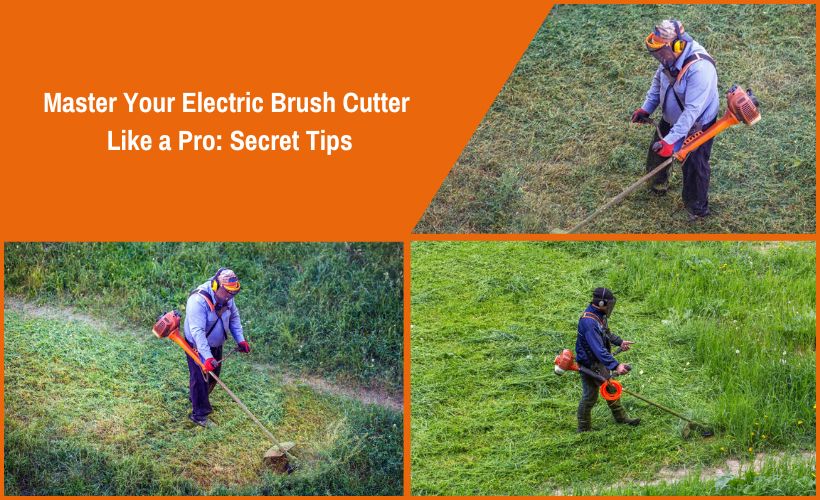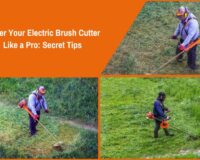Taming an overgrown landscape requires more than just effort; it demands the right tools and skill. The electric brush cutter is one of the most efficient tools for clearing thick weeds, brush, and tall grass, offering both strength and sustainability. But to truly get professional results, you must learn to use it correctly and safely.
This guide will help you master every aspect of using your brush cutter from selecting the right cutting head to applying expert techniques and following essential safety practices.
Mastering your grass cutter machine begins with understanding the different types of attachments and their uses. The electric model is eco-friendly, lightweight, and low on maintenance, making it ideal for residential and professional use alike.
Electric vs. Gas: The Smart Advantage
While gas-powered cutters are known for raw power, electric and battery-operated brush cutters have become increasingly popular due to their convenience. They are quieter, require no fuel mixing, and start instantly. To ensure uninterrupted work, always start with a fully charged battery and keep a spare handy for longer sessions.
Correct use of different types of brush cutters
Choosing the right attachment ensures smoother cutting and saves time:
- Nylon Line/Trimmer Head: Ideal for trimming light grass, edges, and soft weeds.
- Metal Blade (3-Tooth or 4-Tooth): Designed for thicker weeds, tangled grass, and moderate brush.
- Shredder/Saw Blade (Multi-Tooth): Perfect for cutting woody stems, dense thickets, or small saplings.
A well-balanced attachment prevents vibration and enhances precision while using your grass cutting machine manual for detailed or close-up trimming jobs.
Pro Cutting Techniques
Efficient cutting is all about rhythm and control. Most blades rotate counterclockwise, so a right-to-left sweep ensures smooth operation and effective results.
- Standard Sweep: Move in a steady arc from right to left so debris falls on the already cleared area.
- Two-Pass Method: For tall or tangled weeds, first cut the upper half, then make a lower pass to cleanly finish the job.
- On Slopes: Cut in horizontal strips, working upward to maintain balance and minimize strain.
For best performance, keep your grass cutter electric machine steady, and let the blade do the work rather than forcing it through dense patches.
How to use brush cutter safely and effectively
Safety is the foundation of professional operation. Using the Electric brush cutter machine properly ensures efficiency and reduces the risk of injury.
Essential Safety Gear (PPE)
Before powering up, wear:
- Eye and Face Protection: Use safety goggles and a full-face shield.
- Hearing Protection: Wear earmuffs or earplugs to avoid noise damage.
- Protective Clothing: Long sleeves, durable pants, and steel-toed boots are essential.
- Gloves: Help improve grip and reduce vibration fatigue.
Pre-Operation Safety Checklist
Before starting, take a few minutes to ensure everything is in order:
- Inspect the Area: Remove rocks, wires, and debris that could be thrown during cutting.
- Check Equipment: Ensure the blade, guard, and deflectors are secure and in perfect condition.
- Adjust Harness: Balance the weight properly for comfort and stability.
Safe Operation and Maintenance
- Start Safely: Place the cutting head on stable ground before turning on the machine.
- Correct Posture: Maintain a firm grip and use your body to guide the motion.
- Kickback Awareness: Avoid cutting with the 12–3 o’clock blade zone to prevent kickback.
- Breaks: Take short breaks to reduce fatigue during long operations.
- Maintenance: Always disconnect power before cleaning or changing attachments. Clean the cutter head and store in a dry, secure area.
Final Thoughts
With proper technique and consistent safety habits, mastering your electric brush cutter becomes second nature. Whether you’re maintaining a backyard garden or clearing thick overgrowth, this tool offers precision, power, and eco-friendly performance.
By using the right attachments, following correct methods, and respecting safety protocols, you’ll achieve professional-level results every time making your grass cutter machine an essential companion for all your landscaping needs.
FAQ
Q1. Which is better: electric brush cutter or petrol brush cutter?
If you need a tool for home gardens or medium-scale trimming, the electric brush cutter is ideal due to its low noise, zero emissions, and ease of use. For heavy-duty farm or commercial work, petrol models offer more cutting power but require more maintenance.
Q2. How do I choose the right blade size for my brush cutter?
The choice depends on the vegetation type: nylon lines for light grass, 3-tooth blades for dense weeds, and multi-tooth blades for woody growth. Always check your model’s compatibility before changing attachments.
Q3. Why does my brush cutter stop working suddenly?
Common reasons include a clogged cutting head, low battery, overheating, or jammed blades. Always turn off the machine, inspect for obstructions, and let it cool before restarting.




